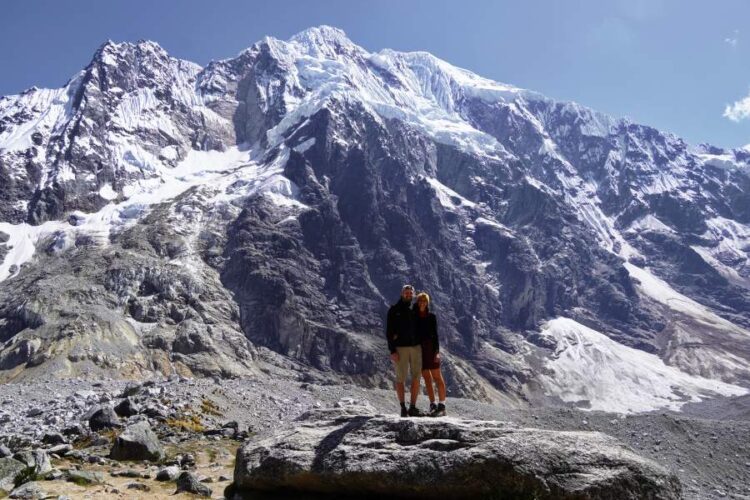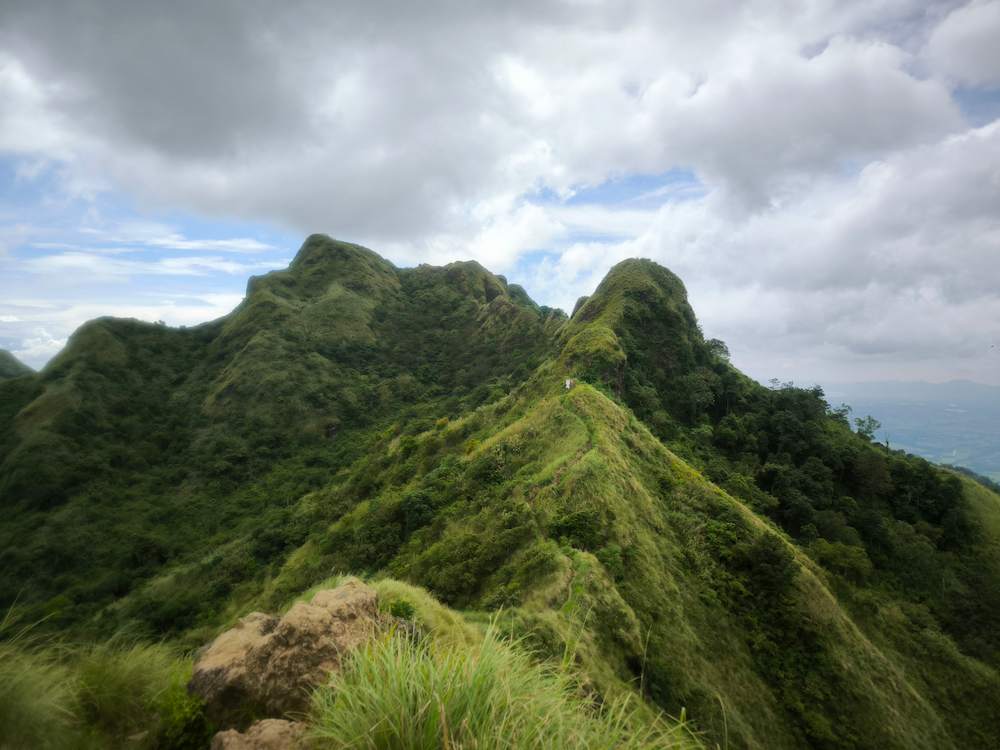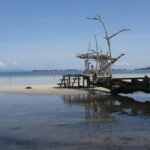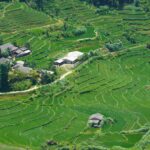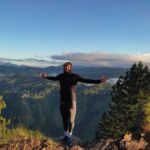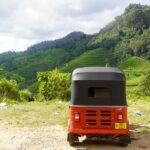Salkantay Trek to Machu Picchu
Of course, a visit to Machu Picchus should not be missing on any trip to Peru. The ruins of the former Inca city on the rock are simply unique. A visit to the famous Machu Picchu is feasible for everyone, as there are various ways to get to the rock. In this article we will limit ourselves to the Salkantay trek, which was for us the most interesting way to get to Machu Picchu. In this article, we will focus on the possibility to do the Salkantay Trek on your own and with your own tent.
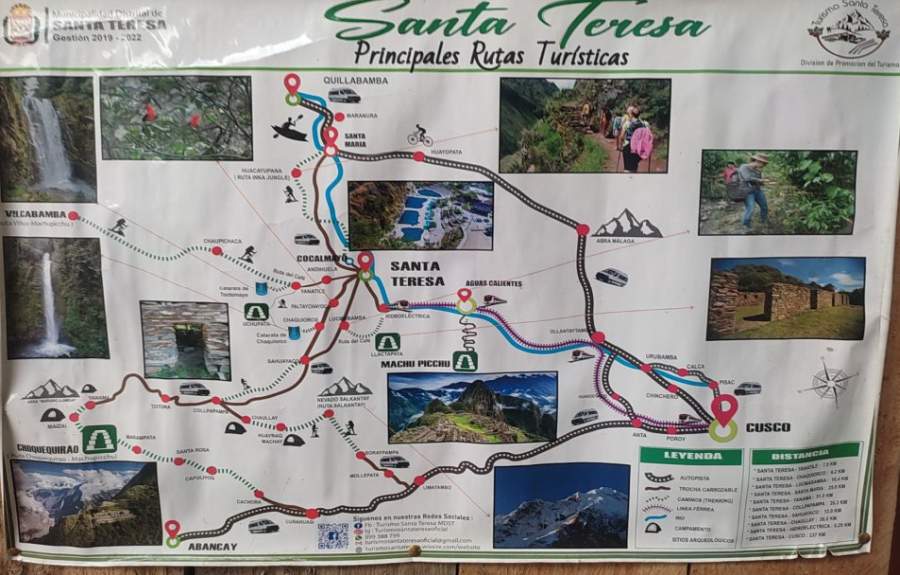
Everything important at a glance
Length: ~ 75 km
Duration: 5 days
Difficulty level: easy to medium
Entrance: 10 Sol for the hike + 70 € for Machu Picchu
Highest point: Salkantay Pass aka the “Gringo Killer” (4,630 m)
General information about the Salkantay Trek
The Salkantay Trek is a wonderful alternative to the over-touristy and overpriced Inca Trail. Since you can not do Inca Trail on your own and a licensed guide is needed, this is accordingly much more expensive. We have heard of costs between 300 € and 1,000 €. The great thing about the Salkantay Trek is that it takes you through different types of landscape and vegetation. First you go into the highlands over the Salkantay Pass at almost 4,600 m before it goes permanently downhill. The trail passes ruins, rivers, coffee, granadilla and orange plantations and finally through rainforest. Along the way there are various types of accommodations, restaurants and small kiosks. The hike itself we would classify between easy and moderate. Sufficient acclimatization is required.
How much does the Salkantay Trek cost?
The Salkantay Trek itself is definitely suitable for budget backpackers and can be mastered virtually without much expense. There is no real entrance fee and for pitching the tent is super cheap. Only the destination of the hike – Machu Picchu has its entrance fee, of course. We had our gas stove with us and took provisions. But there are also enough possibilities on the way for lunch or dinner.
| Output | Cost |
| Transport Cusco – Mollepata | 20 Sol |
| Transport Mollepata – Soraypampa | 35 Sol |
| Entrance Mollepata | 20 Sol |
| 4 x Overnight stay in own tent | 40 Sol |
| Snacks on the way | +/- 15 € |
| 1 x Dinner, 1 x lunch, 1 x breakfast | +/- 10 € |
| Shopping for hike (gas, noodles, dried fruits, cashews, snacks) | +/- 20 € |
| Transport Hydroelectrica – Santa Teresa | 15 Sol |
| Transport Santa Teresa – Santa Maria | 25 Sol |
| Transport Santa Maria – Cusco | 40 Sol |
Day 1: Cusco – Mollepata – Humantay Cococha – Soraypampa – Salkantaypampa (~ 4 Hours walking time; ~ 8 km)
We get up early in the morning and head to the Colectivo station in Cusco. We were told that the first Colectivo leaves around 5:00. For 20 Sol we then went with this to Mollepata. From here you have the option to start hiking or take a transport to Soraypampa. Since we were both still a bit groggy and the landscape didn’t really blow us away, we treated ourselves to a transport for 70 Sol. Unfortunately, we were the only ones doing the trek on our own at the time, which is why we couldn’t share transportation with anyone. But as I said, this is absolutely optional. Arriving in Soraypampa, we were first struck by all the crowds. Hundreds of people poured out of the buses of the tour providers towards the lagoon Humantay Cococha.
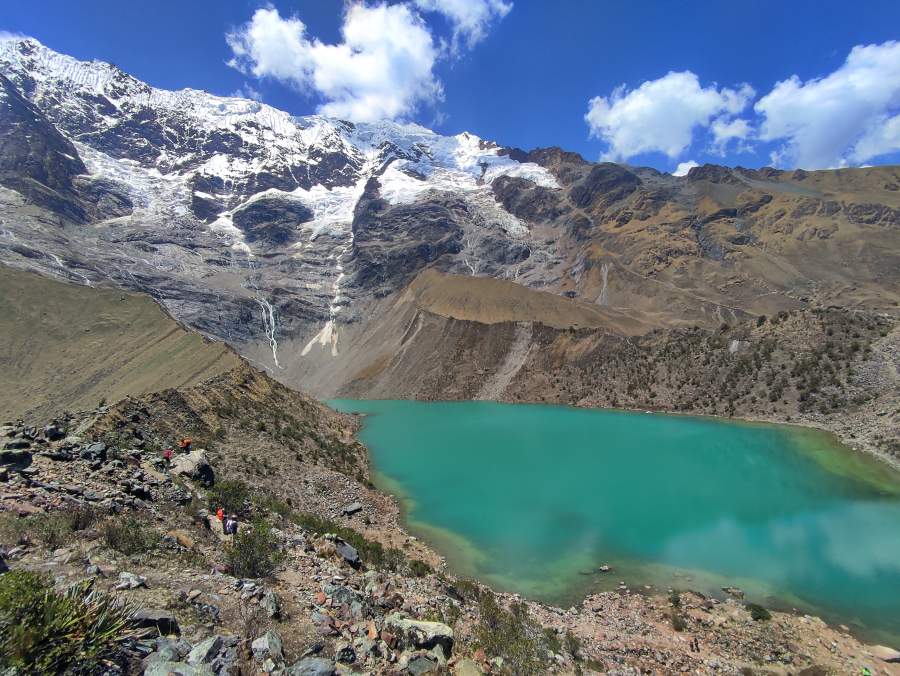
The lagoon itself is beautiful but we honestly lost interest when we saw all the crowds of people. Fortunately, we found that a large part of the people were day tourists who only drove to the lagoon and then back again. Some of them were visibly enjoying being taken to the lagoon on wheezing and croaking and sometimes vomiting horses. After looking at the lagoon, we continue walking for about an hour until we arrive at the foot of Salkantay Pass, the so-called “gringo killer”. Here we pitch our tent with a local family in an area fenced in by stones and thus protected from the wind. For 10 Sol a night we spend the night here, before we start the most strenuous stage of the Salkantay trek the next day. The night is relatively cold and we are glad to have our warm sleeping bags with us.
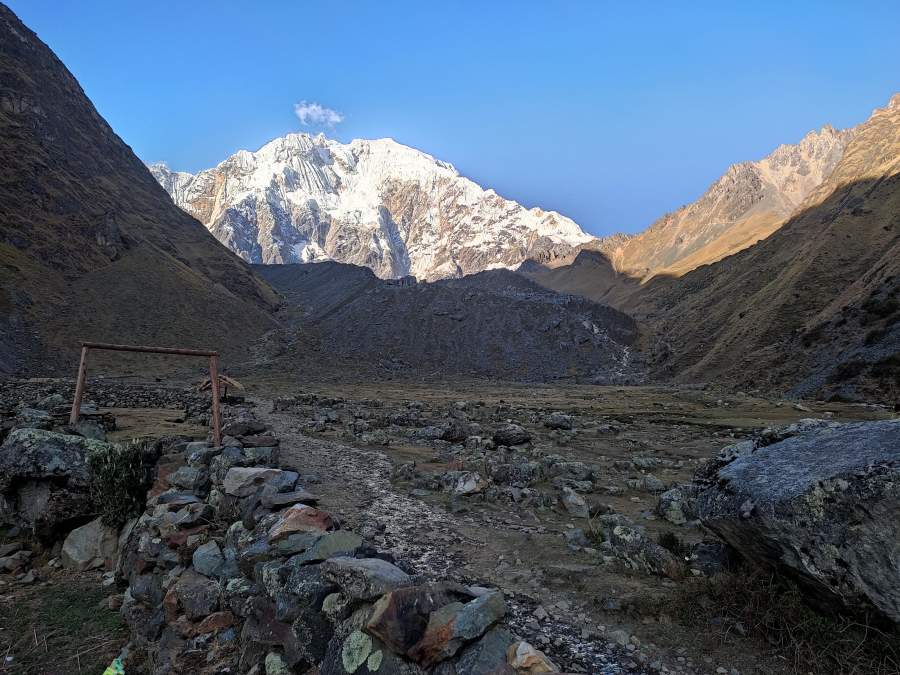
Tip: Leave your bags at one of the restaurants/souvenir stores while you walk to the lagoon. We dragged our bags stupidly up and also back down.
Day 2: Salkantaypampa – Salkantay-Pass (4.630 m) – Chaullay (~8 hours; ~ 18 km)
The second day was announced to us as tough. So we got up early in the morning at 5 o’clock and the first thing we did was the “Gringo Killer”. Fortunately, we were also up before most of the groups. The view from here is beautiful and the climb was much less hard than expected (which doesn’t mean it’s easy).
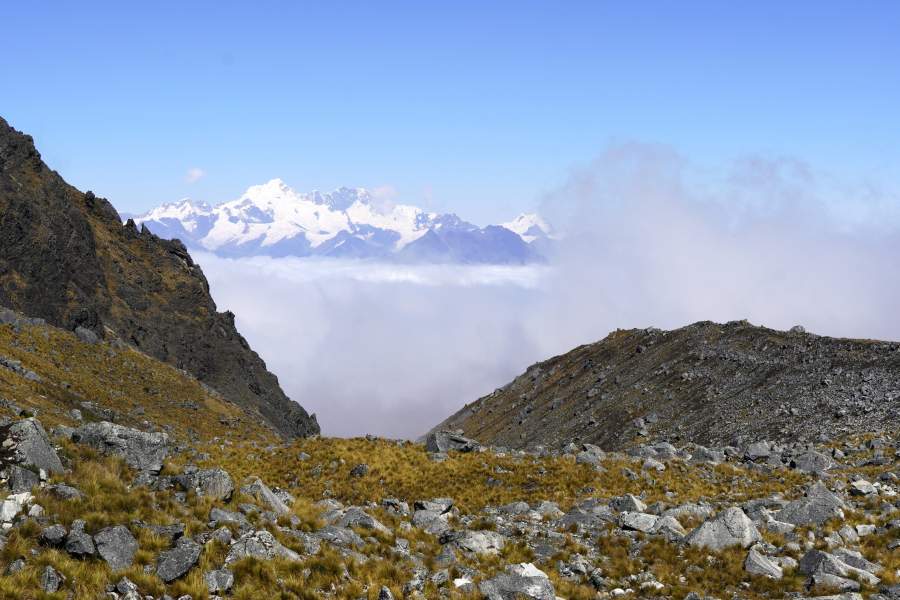
One must also consider that the performance of the body at these altitudes decreases significantly. After we have passed the pass and made a leisurely stop, the descent actually already begins. The path leads us first through a great barren mountain landscape before it becomes more “wooded” further down. In our stage destination Chaullay arrived a nice man offers us that we can put up our tent with him in the garden. Here it pleases us very well and we eat a “Pollo á la Plancha”, a roasted chicken with soup, rice and chips. Here it is already much warmer and cozier at night.
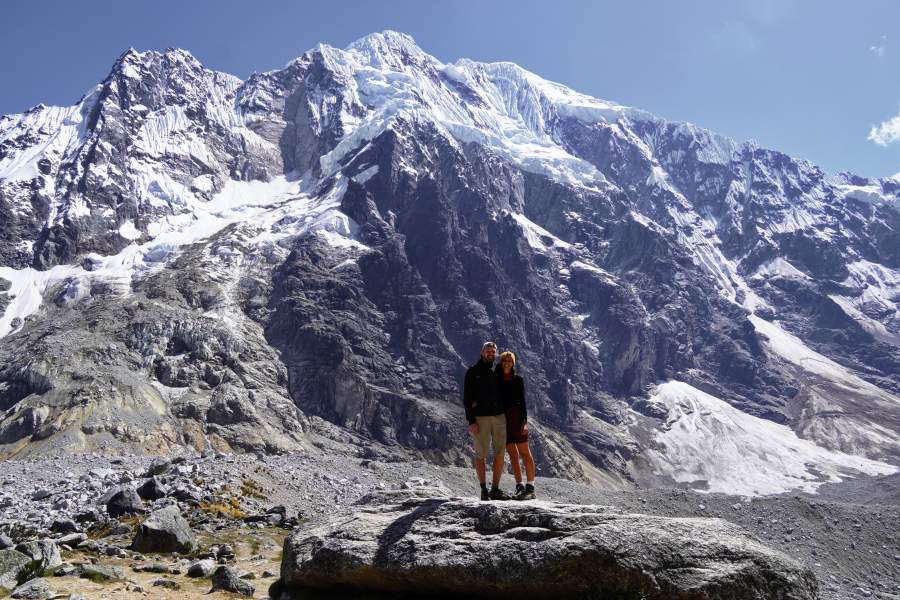
Day 3: Chaullay- Lucmabamba (~6,5 hours)
The third day is honestly a bit monotonous. The first hours the landscape is still quite exciting. The main part of the day consists of walking along the “Rio Santa Teresa”. It is slightly downhill the whole day.
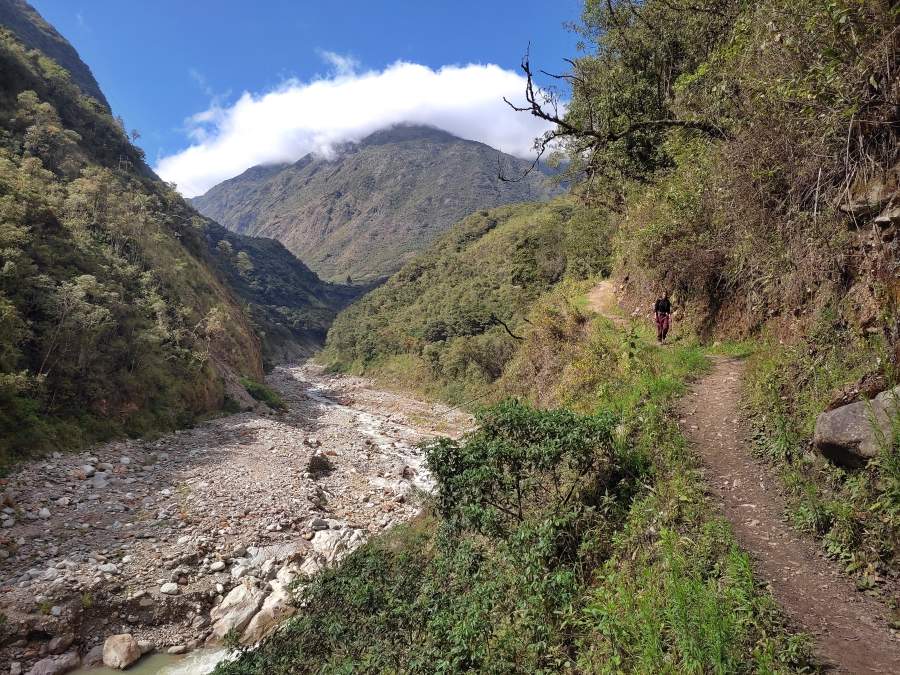
The path leads partly past huge landslides until we reach the sweet village of Lucmabamba in the afternoon. Here we like it totally well and we put up our tent with a super dear old lady in the garden. For the overnight stay we pay again 10 Sol. The nice lady even brings us a plate with popcorn and bananas. Also a cook of the guided tours stays here at the same time as us. He and the nice lady are visibly taken and enthusiastic about our little stove and what we “gringos” conjure up to eat. We prepare a pasta soup and pasta with olive oil, gnocchi and parmesan. In the small village it is worth to walk up the stairs a bit, because most of the sleeping places are here in super idyllic location. In the morning we buy some fruit from the nice lady and prepare our porridge. Around us there are many papayas, orange plantations and granadillas.
Day 4: Lucmabamba – Machu Picchu (~ 8 hours)
The last hiking day is coming up. Today we first climb a few meters up the mountain to Lucmabamba. The path leads us through rainforest and fruit plantations. On the way we drink a delicious freshly squeezed orange juice at a nice lady with a great view.
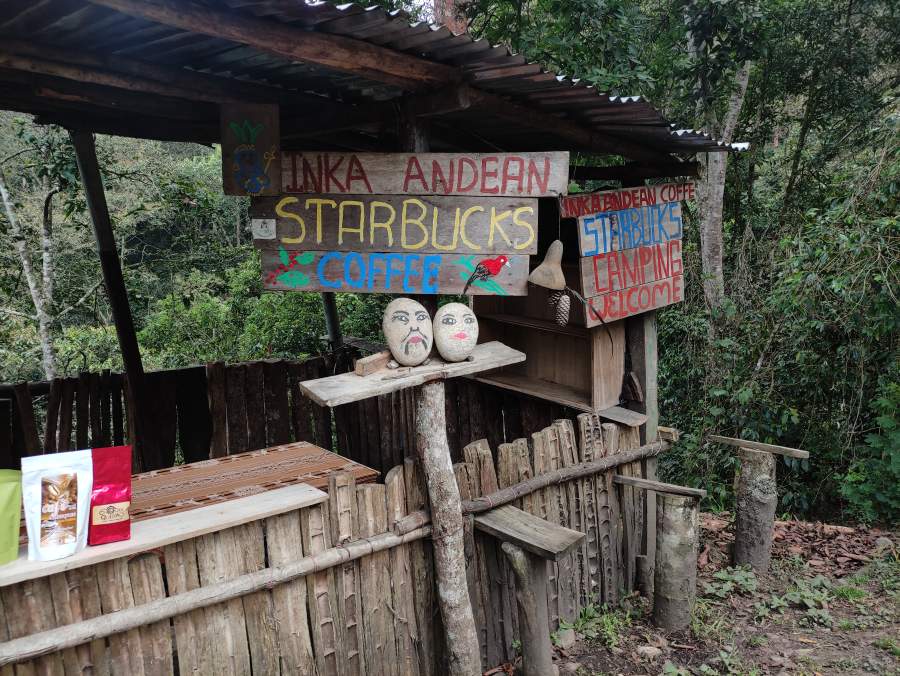
Then we continue dripping with sweat until we reach the Inca ruins of Llactapata, from where you can already catch a first glimpse of the legendary Machu Picchu on a clear day. Unfortunately, the view was a bit hazy, so we could only guess the Machu Picchu. Afterwards it goes some time again steeper downhill.
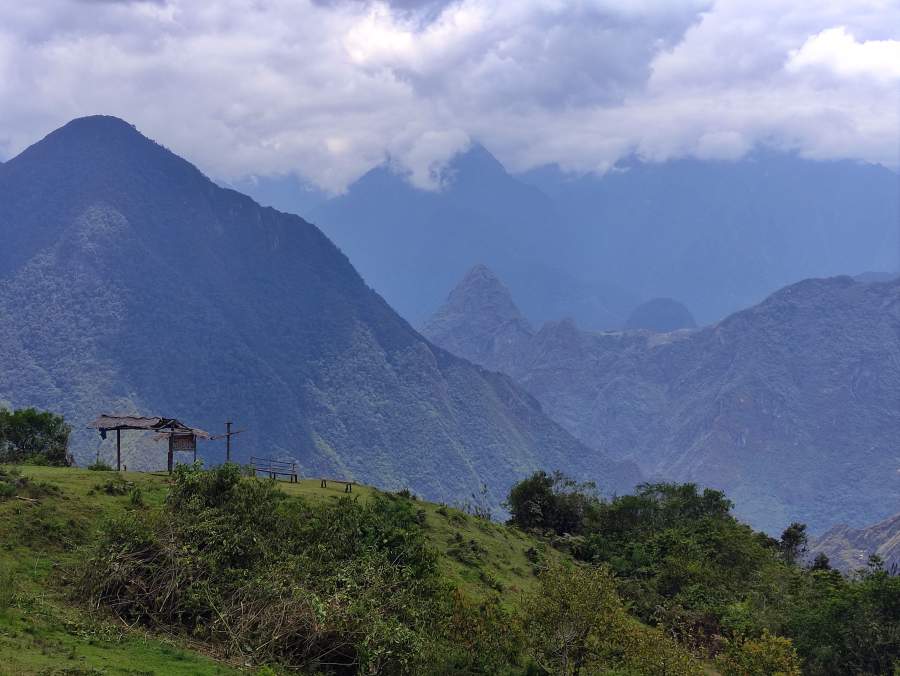
At the bottom we walk a few meters along a dusty road until we arrive at Hydroelectrica. At the railroad tracks we treat ourselves to a cheap “Lomo Saltado” (fried beef strips with peppers and onions in soy sauce, plus fries and salad) for 10 Sol and take a leisurely break. Afterwards it goes still schnurstracks scarce 2 hours along the railroad tracks until we reach our campsite directly before the entrance of the Machu Picchus. Here the night in the tent costs 15 Sol. When setting up the tent, we are unfortunately so bitten, although sprayed with mosquito spray and long pants.
Day 5: Machu Picchu – Santa Teresa – Santa Maria – (Cusco)
Today is the day!! It actually goes on the famous Machu Picchu. Our ticket is only valid from 13:00, which is why we sleep in comfortably, get breakfast, sandwiches and fresh orange juice at one of the stalls. On foot it is 5 minutes to the entrance of Machu Picchu. We do without the bus for 15 €, which goes up to the top. We talk to the receptionist of the campsite and can leave our things there while we go to Machu Picchu. One hour before we are already allowed to go up. About the Machu Picchu itself we have written a separate article. Around 16:00 we come back down, pack our things and march off to Hydroelectrica. We were told that the last colectivo to Santa Teresa already leaves at 18:00. We walk at a brisk pace and reach the last colectivo. We share the ride with an old drunken and rather confused man, who probably also has shat himself in his pants*. After about half an hour we arrive in Santa Maria, where they let us out at the colectivo station. The next colectivo takes us seamlessly on to Santa Maria – everything runs like clockwork! In Santa Maria we talk with a Colectivo driver, because of a trip to Cusco. In the meantime it is already 20:00 o’clock and we are quite tired! We go to eat something and wait for more passengers. When also after 2 hours no guests came, we ask at the opposite Kioks about bus tickets. The next bus at 22:00 is full but there is still room in the following one. What we did not know is that the trip would take 5 hours. This is too long for us and we take a room for 30 Sol together in Santa Maria. We buy a bus ticket for the next morning and go to sleep.
Info: If you have an earlier ticket to Machu Picchu you will of course make it back to Cusco the same day.
Day 6: Santa Maria – Cusco
In the morning at 7:00 we take the bus back to Cusco, where we arrive at our hostel around 13:00. To celebrate the day we can have a delicious pizza in Cusco and snuggle comfortably in our bed.
Packing List for your Salkantay Trek
In our packing list, of course, we make no claim to completeness. We have previously made a list of things that we need and still have to buy. Since we wanted to make the trek with our own tent and food, we of course had to carry much more equipment. Who decides on the way for accommodation and food, of course, has much less luggage to carry.
Acommodation
- Sleeping bag ( min. – 5 °C comfort temperature, better even warmer)
- Tent (for us 3 persons was ideal, because we had space for the bags)
Clothing
- Snacks (muesli bars, Snickers, Twix and nuts)
- 1 x Warm jacket
- 1 x hiking pants
- 1 x short hiking pants
- 2 x hiking socks + if necessary 1 x warm wool socks for at night
- Sports vest
- Woolen cap
- 1 x multifunctional headscarf
- 2 x dry-fit sports shirts
- Rain jacket or poncho
- Hiking boots
- Underwear
Equipment
- Large backpack with raincover
- Offline map app (e.g. maps.me or mappy.cz)
- Headlamp or flashlight
- Camera
- Sunscreen
- Mosquito spray!!!
- Filter bottle (Lifestraw)
- Cooking pot (at best a foldable one made of silicone)
- Spork
- Metal cups for tea
- Camping stove
- Plate (at best a foldable one made of silicone)
- 1 x gas cartridge
Catering
- 2 x 250 g pasta
- 1 x 500 g couscous
- 250 g soup noodles
- 150 g oat flakes
- 4 x carrot
- 200 g dried fruit
- 200 g nuts
- 2 x Snickers
- 2 x packs of muesli bars
- 1x pack of parmesan
- 1 x small olive oil
- 1 x packet of stock cubes (vegetarian or chicken flavor)
- Salt
Medication
- Blister plaster
- Gauze bandages
- Pills against altitude sickness
- Medicines for diarrhea, headache and pain pills
- Magnesium tablets
Salkantay Trek on your own or with a tour?
Those who know us a bit by now know that we much prefer to do such treks on our own. Even though about 95% of the people we met have booked a tour. The trek itself is super easy to complete. The trails are easy to see and with the help of offline maps nothing should go wrong. Prerequisite is, of course, a good acclimatization in Cusco, because it goes at the Salkantay Pass on almost 4,600 m high. What also speaks for making the trek on your own: There are enough accommodations and possibilities to eat on the way, so you don’t really need to bring any equipment for it.
Acclimatization for the Salkantay trek
Sufficient acclimatization before the Salkantay hike is necessary, as you will spend the first night at over 4,000 meters. It is best to stay in Cusco for a few days before the start of the hike – there is plenty to do. Since we drove directly from Huaraz and the super beautiful Huayhuash trek to Cusco, we were already well acclimatized for the Salkantay trek. Before starting the trek you can spend some time in the beautiful city of Cusco, visit the Sacred Valley and to an acclimatization hike to the beautiful Rainbow Mountain
Accommodation on the Salkantay Trek
Throughout the hike, there were a wide variety of accommodations. From the so-called “domes”, which strongly resemble golf balls in shape, to hostels, there are also accommodations of various price ranges. The same applies to restaurants. Depending on the season, it may be advisable to contact the accommodations in advance. But we are sure, somewhere there is always a place to sleep.
Arrival Salkantay Trek
The journey to your hike to Machu Picchu takes place from Cusco. With the Colectivo it goes first to Mollepata. We allowed ourselves the luxury and drove further to Soraypampa, from where most tours start.
Departure from Salkantay Trek
Here there are various options, namely train, colectivo and bus or a combination of train and bus. Those who do not take the train must first walk along the rails from Machu Picchu to Hydroelectica (+/- 2 hours). Briefly, all departure options that include the train are significantly more expensive, as the train alone from Aguas Calientes (Machu Picchu Village) to Hydroelectrica already costs over 30 €.
bus: Once a day there is a bus from Hydroelectrica to Cusco. This drives around 14:00 – 15:00 clock we were told.
colectivos: Hydroelectrica – Santa Teresa – Santa Maria – Cusco:
train & colectivos bzw. Bus: By train, you can go from Aguas Calientes to Hydroelectrica and get on a colectivo or bus.
Meals during the Salkantay Trek
On the way there are various possibilities to buy snacks and freshly squeezed orange juice. Partly it is necessary to negotiate a little.
[WPSM_AC id=7287]


